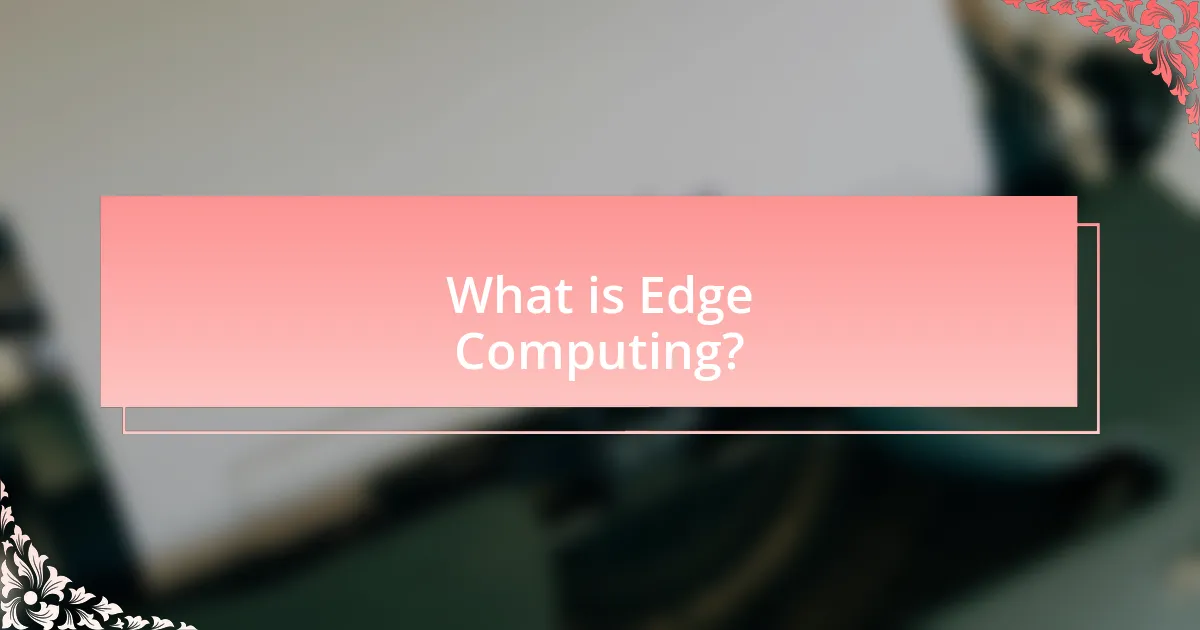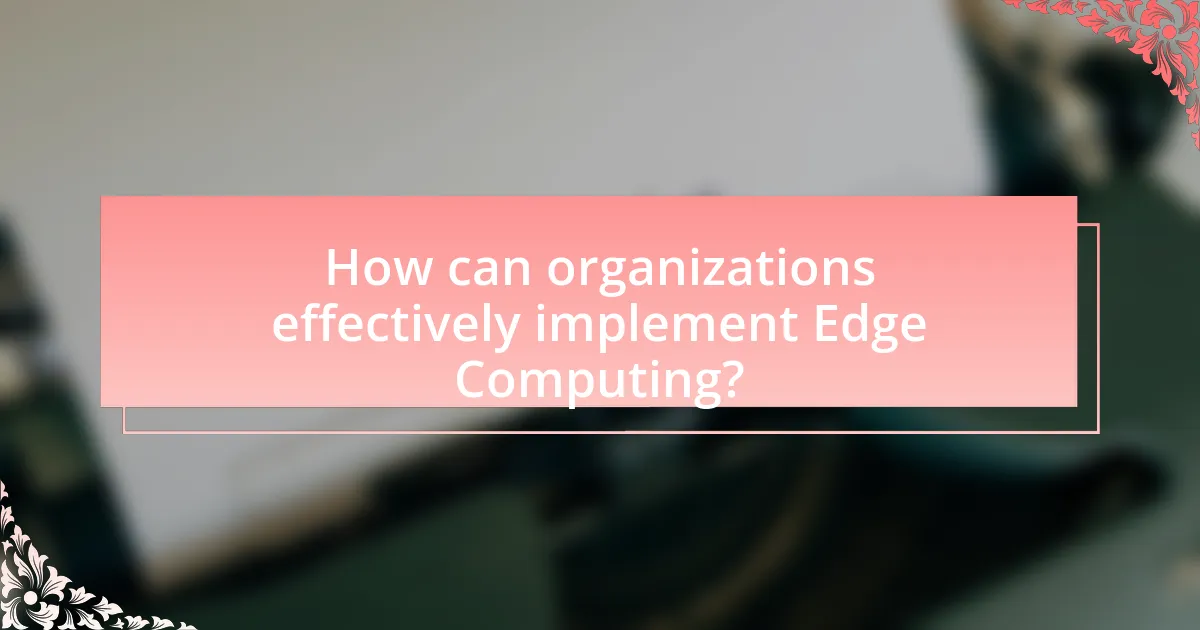Edge computing is a distributed computing paradigm that enhances data processing by bringing computation and storage closer to the data source, thereby reducing latency and bandwidth usage. This article explores the differences between edge computing and traditional cloud computing, highlighting its key characteristics, primary use cases, and the critical role it plays in real-time data processing, particularly in IoT applications. It also addresses the challenges faced by edge computing, including security concerns and scalability issues, while outlining best practices for effective implementation. Additionally, the article discusses the impact of emerging technologies like 5G and the future prospects of edge computing, emphasizing its growing importance in modern digital infrastructure.

What is Edge Computing?
Edge computing is a distributed computing paradigm that brings computation and data storage closer to the location where it is needed, improving response times and saving bandwidth. This approach reduces latency by processing data at the edge of the network, rather than relying on a centralized data center. According to a report by Gartner, by 2025, 75% of enterprise-generated data will be created and processed outside a traditional centralized data center, highlighting the increasing reliance on edge computing for real-time data processing and analytics.
How does Edge Computing differ from traditional cloud computing?
Edge computing processes data closer to the source of generation, while traditional cloud computing relies on centralized data centers for processing. This proximity in edge computing reduces latency, enhances real-time data processing, and minimizes bandwidth usage, as data does not need to travel long distances to reach a central server. For instance, in applications like autonomous vehicles or smart manufacturing, edge computing enables immediate decision-making by analyzing data on-site, whereas traditional cloud computing may introduce delays due to data transmission times.
What are the key characteristics of Edge Computing?
Edge computing is characterized by its ability to process data closer to the source of generation, which reduces latency and bandwidth usage. This decentralized approach allows for real-time data processing and analysis, enhancing responsiveness and efficiency in applications such as IoT and autonomous systems. Additionally, edge computing improves data security by minimizing the amount of sensitive information transmitted over networks, as processing occurs locally. According to a report by Gartner, by 2025, 75% of enterprise-generated data will be created and processed outside a centralized data center, highlighting the growing reliance on edge computing for efficient data management.
Why is latency a critical factor in Edge Computing?
Latency is a critical factor in Edge Computing because it directly impacts the speed and responsiveness of applications and services. In Edge Computing, data processing occurs closer to the source of data generation, which significantly reduces the time it takes for data to travel to and from centralized cloud servers. For instance, applications in sectors like autonomous vehicles or real-time remote monitoring require minimal latency to function effectively; even a few milliseconds of delay can lead to failures or safety issues. Studies have shown that reducing latency can enhance user experience and operational efficiency, making it essential for applications that demand real-time data processing and analysis.
What are the primary use cases for Edge Computing?
The primary use cases for Edge Computing include real-time data processing, IoT device management, content delivery, and enhanced security. Real-time data processing is crucial in applications such as autonomous vehicles and industrial automation, where immediate analysis is necessary for safety and efficiency. IoT device management benefits from Edge Computing by reducing latency and bandwidth usage, allowing for quicker responses and better resource allocation. Content delivery networks utilize Edge Computing to cache data closer to users, improving load times and user experience. Enhanced security is achieved through localized data processing, which minimizes the risk of data breaches by keeping sensitive information closer to its source. These use cases demonstrate the significant role Edge Computing plays in optimizing performance and reliability across various industries.
How is Edge Computing utilized in IoT applications?
Edge computing is utilized in IoT applications by processing data closer to the source of generation, which reduces latency and bandwidth usage. This decentralized approach allows IoT devices to analyze and act on data in real-time, enhancing responsiveness and efficiency. For instance, in smart manufacturing, edge computing enables machines to monitor performance and detect anomalies instantly, leading to quicker decision-making and reduced downtime. According to a report by Gartner, by 2025, 75% of enterprise-generated data will be created and processed outside centralized data centers, highlighting the critical role of edge computing in optimizing IoT operations.
What role does Edge Computing play in real-time data processing?
Edge Computing plays a crucial role in real-time data processing by enabling data to be processed closer to the source of generation, thereby reducing latency and bandwidth usage. This proximity allows for faster decision-making and immediate responses, which are essential in applications such as autonomous vehicles, industrial automation, and smart cities. For instance, according to a report by Gartner, by 2025, 75% of enterprise-generated data will be processed outside the centralized data center, highlighting the shift towards edge solutions for timely data handling.

Why is Edge Computing becoming increasingly important?
Edge Computing is becoming increasingly important due to its ability to process data closer to the source, which reduces latency and bandwidth usage. This technology enables real-time data analysis and decision-making, essential for applications like IoT devices, autonomous vehicles, and smart cities. According to a report by Gartner, by 2025, 75% of enterprise-generated data will be created and processed outside centralized data centers, highlighting the shift towards decentralized computing. This trend is driven by the need for faster response times and improved efficiency in data handling, making Edge Computing a critical component of modern digital infrastructure.
What trends are driving the growth of Edge Computing?
The growth of Edge Computing is primarily driven by the increasing demand for real-time data processing and low-latency applications. As businesses adopt IoT devices and smart technologies, the need for faster data analysis at the source has become critical. According to a report by Gartner, by 2025, 75% of enterprise-generated data will be created and processed outside centralized data centers, highlighting the shift towards decentralized computing. Additionally, the rise of 5G technology enhances connectivity and speeds, further facilitating the deployment of Edge Computing solutions. This trend is supported by the growing focus on data privacy and security, as processing data closer to its source reduces the risk of breaches during transmission.
How is the rise of IoT influencing Edge Computing adoption?
The rise of IoT is significantly accelerating the adoption of Edge Computing by necessitating real-time data processing closer to the data source. As IoT devices proliferate, generating vast amounts of data, traditional cloud computing becomes less efficient due to latency issues and bandwidth constraints. According to a report by Gartner, by 2025, 75% of enterprise-generated data will be created and processed outside centralized data centers, highlighting the shift towards Edge Computing. This trend is driven by the need for faster response times and reduced data transmission costs, making Edge Computing a critical component in managing the demands of IoT ecosystems.
What impact does 5G technology have on Edge Computing?
5G technology significantly enhances Edge Computing by providing ultra-low latency and high-speed connectivity, which are essential for real-time data processing. This improved performance allows edge devices to process data closer to the source, reducing the need for data to travel to centralized cloud servers. For instance, 5G networks can achieve latency as low as 1 millisecond, compared to 4G’s average of 30-50 milliseconds, enabling applications like autonomous vehicles and smart cities to function effectively. Additionally, the increased bandwidth of 5G supports a higher density of connected devices, facilitating the deployment of IoT solutions that rely on Edge Computing for immediate data analysis and decision-making.
What challenges does Edge Computing face?
Edge Computing faces several challenges, including security vulnerabilities, interoperability issues, and limited processing power. Security vulnerabilities arise due to the distributed nature of edge devices, which can be more susceptible to attacks compared to centralized systems. Interoperability issues occur because various devices and platforms may not communicate effectively, complicating integration. Additionally, limited processing power at the edge can hinder the ability to perform complex computations, necessitating a balance between local processing and cloud resources. These challenges are critical as they impact the deployment and effectiveness of Edge Computing solutions in various applications.
How do security concerns affect Edge Computing implementations?
Security concerns significantly impact Edge Computing implementations by necessitating robust security measures to protect data and devices at the network’s edge. The distributed nature of Edge Computing increases vulnerability to cyberattacks, as devices often operate in less secure environments compared to centralized data centers. For instance, a report by the Cybersecurity & Infrastructure Security Agency (CISA) highlights that 70% of organizations experienced an increase in cyber threats due to the proliferation of IoT devices, which are commonly integrated into Edge Computing frameworks. Consequently, organizations must implement advanced security protocols, such as encryption, authentication, and regular software updates, to mitigate risks and ensure data integrity and confidentiality.
What are the scalability issues associated with Edge Computing?
Scalability issues associated with Edge Computing include limited resources, network latency, and management complexity. Limited resources arise because edge devices often have less processing power and storage compared to centralized cloud systems, which can hinder the ability to scale applications effectively. Network latency can become a bottleneck as the number of edge devices increases, leading to delays in data transmission and processing. Additionally, management complexity escalates with a larger number of distributed devices, making it challenging to maintain, update, and secure the edge infrastructure. These factors collectively impede the seamless scalability of Edge Computing solutions.

How can organizations effectively implement Edge Computing?
Organizations can effectively implement Edge Computing by strategically deploying edge devices, optimizing data processing at the source, and ensuring robust network connectivity. This approach allows for real-time data analysis and reduced latency, which are critical for applications like IoT and autonomous systems. According to a report by Gartner, by 2025, 75% of enterprise-generated data will be created and processed outside centralized data centers, highlighting the necessity for organizations to adopt edge computing solutions to stay competitive. Additionally, implementing security measures at the edge is essential, as edge devices can be vulnerable to cyber threats. By focusing on these key areas, organizations can leverage the benefits of Edge Computing to enhance operational efficiency and drive innovation.
What best practices should organizations follow for Edge Computing deployment?
Organizations should follow several best practices for Edge Computing deployment to ensure efficiency and security. First, they should assess their specific use cases and determine the appropriate edge architecture, which can include a mix of on-premises and cloud resources. This tailored approach allows organizations to optimize performance and reduce latency, as evidenced by a study from Gartner indicating that 75% of enterprise-generated data will be created and processed outside centralized data centers by 2025.
Next, organizations must prioritize security by implementing robust encryption and access controls at the edge, as edge devices can be vulnerable to attacks. According to a report by Cybersecurity Ventures, cybercrime is projected to cost the world $10.5 trillion annually by 2025, highlighting the critical need for strong security measures.
Additionally, organizations should invest in monitoring and management tools that provide real-time insights into edge operations, enabling proactive maintenance and quick response to issues. A survey by IDC found that 80% of organizations believe that real-time data analytics at the edge will be crucial for their digital transformation efforts.
Finally, fostering collaboration between IT and operational technology teams is essential for successful deployment, as it ensures alignment on goals and strategies. Research from McKinsey shows that organizations with cross-functional teams are 1.5 times more likely to achieve their digital transformation objectives.
How can businesses ensure data security at the edge?
Businesses can ensure data security at the edge by implementing robust encryption protocols for data in transit and at rest. This approach protects sensitive information from unauthorized access during transmission and storage. Additionally, deploying advanced threat detection systems can identify and mitigate potential security breaches in real-time. According to a report by Gartner, organizations that adopt a layered security strategy, including endpoint protection and network segmentation, can reduce the risk of data breaches by up to 60%. Regular security audits and compliance checks further enhance data security by ensuring adherence to industry standards and regulations.
What strategies can optimize performance in Edge Computing environments?
To optimize performance in Edge Computing environments, implementing data processing at the edge, utilizing efficient resource management, and ensuring robust security measures are essential strategies. Data processing at the edge reduces latency by minimizing the distance data must travel, which is critical for real-time applications. Efficient resource management, including load balancing and dynamic resource allocation, enhances system responsiveness and maximizes throughput. Additionally, robust security measures, such as encryption and access controls, protect sensitive data and maintain system integrity. These strategies collectively improve performance by ensuring faster data handling, optimal resource use, and secure operations in Edge Computing environments.
What tools and technologies are essential for Edge Computing?
Essential tools and technologies for Edge Computing include edge devices, edge servers, and networking technologies such as 5G. Edge devices, like IoT sensors and gateways, facilitate data collection and processing at the source, reducing latency. Edge servers provide localized computing power, enabling real-time analytics and decision-making closer to the data source. Networking technologies, particularly 5G, enhance connectivity and bandwidth, allowing for faster data transmission between edge devices and central systems. These components collectively support the efficient operation of edge computing environments, addressing the need for low-latency processing and improved data management.
Which platforms support Edge Computing solutions?
Major platforms that support Edge Computing solutions include Microsoft Azure IoT Edge, Amazon Web Services (AWS) Greengrass, Google Cloud IoT Edge, IBM Edge Application Manager, and Cisco Edge Computing Solutions. These platforms provide tools and services that enable data processing and analytics closer to the source of data generation, enhancing performance and reducing latency. For instance, Microsoft Azure IoT Edge allows users to deploy cloud workloads, such as machine learning models, directly to IoT devices, facilitating real-time data processing.
What role do edge devices play in the Edge Computing ecosystem?
Edge devices serve as critical components in the Edge Computing ecosystem by processing data closer to the source, thereby reducing latency and bandwidth usage. These devices, which include sensors, gateways, and IoT devices, enable real-time data analysis and decision-making at the edge of the network rather than relying solely on centralized cloud resources. This localized processing is essential for applications requiring immediate responses, such as autonomous vehicles and smart manufacturing. According to a report by Gartner, by 2025, 75% of enterprise-generated data will be created and processed outside a traditional centralized data center, highlighting the increasing reliance on edge devices for efficient data management and operational effectiveness.
What are the future prospects of Edge Computing?
The future prospects of Edge Computing are highly promising, driven by the increasing demand for real-time data processing and low-latency applications. As organizations adopt IoT devices and smart technologies, the need for decentralized computing solutions that minimize latency and bandwidth usage will grow. According to a report by MarketsandMarkets, the Edge Computing market is projected to reach $43.4 billion by 2027, growing at a CAGR of 38.4% from 2022. This growth is fueled by advancements in 5G technology, which enhances connectivity and enables more devices to operate efficiently at the edge. Additionally, industries such as healthcare, manufacturing, and autonomous vehicles are increasingly leveraging Edge Computing to improve operational efficiency and decision-making processes.
How might Edge Computing evolve in the next decade?
Edge Computing is expected to evolve significantly in the next decade through increased integration with artificial intelligence and the Internet of Things (IoT). This evolution will enhance real-time data processing capabilities, allowing for faster decision-making and reduced latency in applications such as autonomous vehicles and smart cities. According to a report by Gartner, by 2025, 75% of enterprise-generated data will be created and processed outside centralized data centers, highlighting the shift towards decentralized computing. Additionally, advancements in 5G technology will further facilitate the growth of edge computing by providing the necessary bandwidth and connectivity for a larger number of devices, thereby expanding its applications across various industries.
What innovations are expected to shape the future of Edge Computing?
Innovations expected to shape the future of Edge Computing include advancements in artificial intelligence, 5G connectivity, and the integration of Internet of Things (IoT) devices. Artificial intelligence enhances data processing at the edge, enabling real-time analytics and decision-making, which is crucial for applications like autonomous vehicles and smart cities. The rollout of 5G technology significantly increases bandwidth and reduces latency, allowing for faster data transmission and improved performance of edge devices. Additionally, the proliferation of IoT devices generates vast amounts of data that require efficient processing at the edge to minimize latency and bandwidth usage, thus driving the need for more sophisticated edge computing solutions. These innovations collectively enhance the capabilities and applications of edge computing across various industries.
What practical steps can organizations take to leverage Edge Computing?
Organizations can leverage Edge Computing by implementing localized data processing, which reduces latency and bandwidth usage. To achieve this, they should deploy edge devices that can process data closer to the source, such as IoT sensors or gateways. Additionally, organizations must invest in robust network infrastructure to support real-time data transmission and ensure seamless connectivity between edge devices and central systems.
Furthermore, adopting a hybrid cloud strategy allows organizations to balance workloads between edge and cloud environments, optimizing resource utilization. Training staff on edge computing technologies and best practices is essential for maximizing the benefits of this approach. According to a report by Gartner, by 2025, 75% of enterprise-generated data will be created and processed outside the centralized data center, highlighting the necessity for organizations to adopt edge computing strategies.


